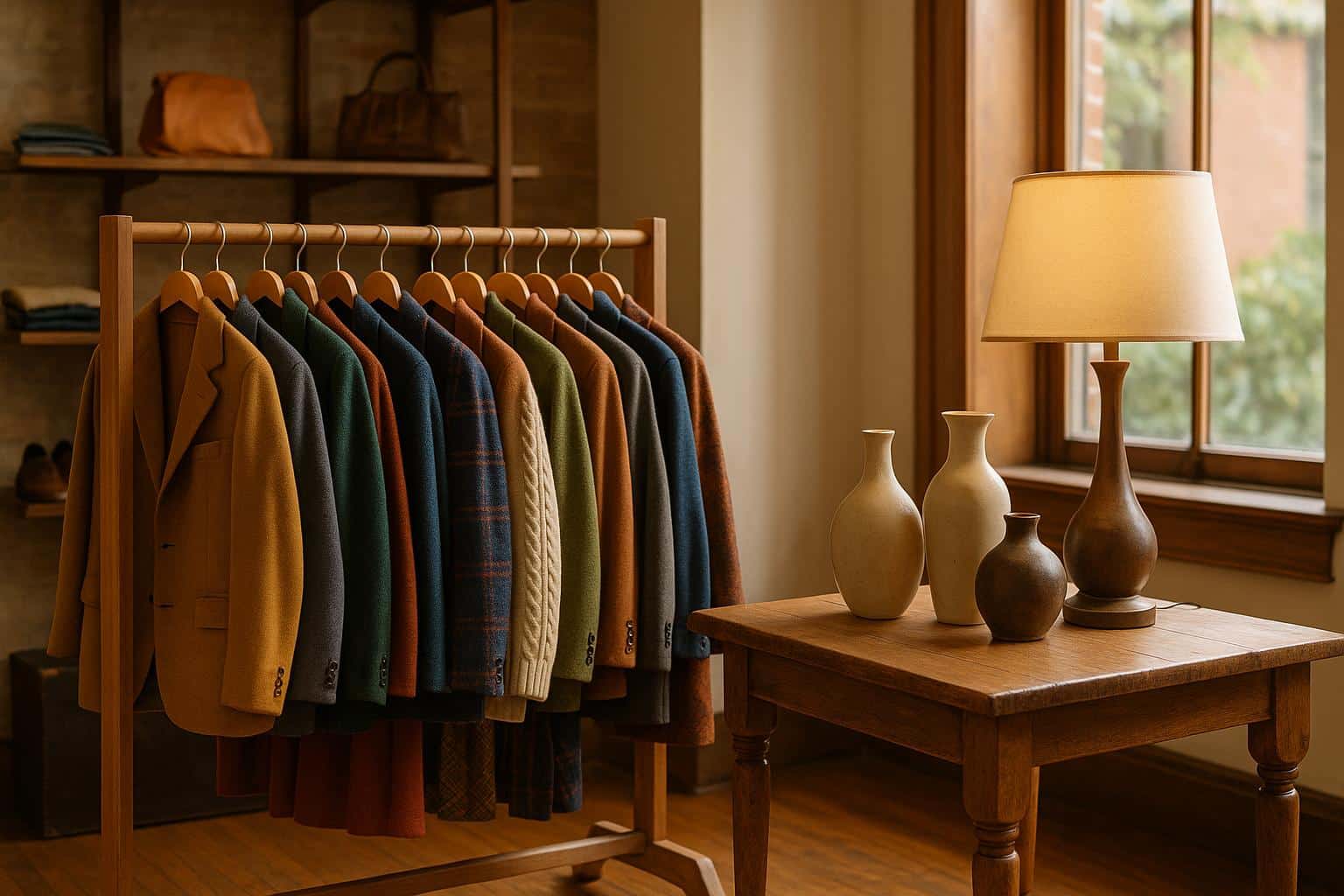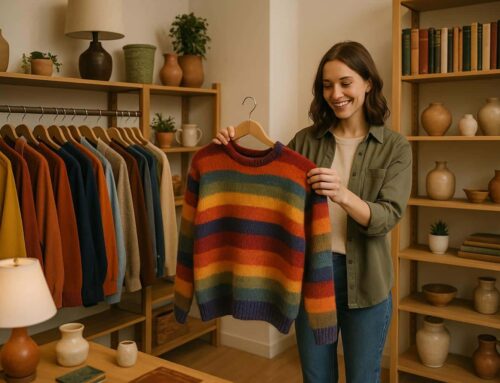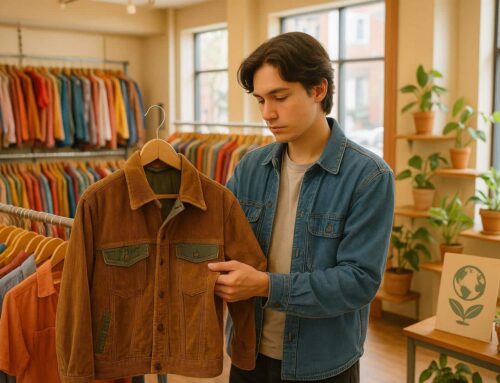Thrift shopping offers three key benefits: saving money, reducing waste, and finding one-of-a-kind items. You can often find quality clothing, furniture, and household goods at 70–85% less than retail prices, while also helping to cut down on the 11 million tons of textile waste generated annually in the U.S. To ensure you’re getting durable, well-made items, focus on these steps:
- Materials: Look for natural fibers like cotton, wool, silk, or solid wood for furniture. High-quality materials last longer and often improve with use.
- Construction: Check for tight stitching, functional zippers, dovetail joints in furniture, and smooth finishes. These details indicate better craftsmanship.
- Brands: Read labels for vintage or designer names and unique markers like serial numbers or union tags to verify authenticity.
- Condition: Inspect for wear, damage, or stains. Minor flaws like loose buttons or scratches can often be repaired, but severe issues may not be worth the cost.
- Research: Use your smartphone to check resale values or confirm collectible items. Look for maker marks or unique details that signal higher value.
How to Identify Quality Materials and Construction
The difference between a $5 thrift store gem that lasts for years and one that falls apart after a few washes often comes down to the materials and how well it’s made. Knowing what to look for can help you spot items that will stand the test of time.
Finding Durable Materials
When it comes to clothing, natural fibers are a safe bet. Materials like cotton, wool, silk, and linen not only feel better against the skin but also tend to last longer than synthetic options. Natural fibers are generally more breathable, hold their shape better, and often improve with wear.
Start by checking the fabric label. Look for garments made with high percentages of natural fibers – ideally 100% cotton, wool, or silk. These materials are more likely to offer durability and comfort. For example:
- Cotton: High-quality cotton feels crisp and sturdy, not thin or flimsy.
- Wool: A good wool piece will be soft, dense, and resilient, without feeling scratchy.
- Linen: Authentic linen often has small, raised imperfections called “slubs”, a sign of its natural origin.
- Silk: Quality silk should feel substantial, drape elegantly, and be thick enough to provide coverage.
For furniture, the same principles apply. Solid wood pieces, especially those made from oak, hickory, or mahogany, are far more durable than particleboard or composite materials. You can often identify solid wood by its weight – heavier pieces feel stable and sturdy.
When it comes to leather, opt for full-grain or top-grain leather over corrected-grain or bonded options. Quality leather feels supple yet firm and often features visible, natural grain patterns.
Checking Construction Quality
The way an item is constructed plays a big role in how long it will last. For clothing, examine the stitching. High-quality garments feature even, tightly spaced stitches that lie flat against the fabric. Look for reinforced stitching at stress points like pockets, armholes, and seams. Taped seams – where raw edges are covered with fabric – are another indicator of superior craftsmanship.
Test moving parts, like zippers and buttons. Zippers should glide easily without snagging, and buttons should be firmly attached with no loose threads. For vintage pieces, ensure that snaps, hooks, and other closures are still functional.
For furniture, construction quality is often revealed in the joinery. Solid wood furniture typically uses dovetail, bridle, or finger joints instead of nails or glue. Dovetail joints, for example, can be spotted in drawer corners and resemble interlocking teeth. Handmade dovetailing may look slightly uneven, while machine-made joints are usually perfectly uniform.
Test drawers and doors: drawers should slide smoothly, and doors should open and close without sticking or wobbling. A quality finish is smooth, with no cracks, bubbles, or visible glue marks. For upholstered furniture, lift one corner to test the frame – it should feel stable and silent under pressure.
Weight can also be a good indicator of quality. A heavier wooden table often signifies solid construction, while substantial hardware on bags or home goods suggests better craftsmanship.
The overall finish of an item – aligned seams, even edges, and securely attached decorative details – reflects the care that went into its creation. As Phillip Nakov, a lifelong collector and former antique store owner, explains:
“Attention to detail, symmetry, and finishing touches distinguish well-made items from mass-produced ones.”
How to Check Brands and Verify Items
Getting the hang of reading labels and spotting authentic designer details can make thrift shopping a lot more satisfying. The difference between snagging a true vintage gem and picking up a modern knockoff often comes down to noticing the small, often overlooked details.
Reading Labels and Tags
Labels are like a window into an item’s history. Start by checking the label’s quality – it should feel sturdy and be securely stitched. As Cynthia Kennedy, a personal fashion stylist and image consultant, points out:
“The tag should be neatly sewn, flat and designed in the right font for the brand. If the tag is misspelled or crooked, that’s a dead giveaway.”
Look for labels that include the brand name, logo, care instructions, and country of origin. Many designer items also feature unique serial or model numbers and season codes, which are great for verifying authenticity. Pay close attention to the typography – vintage labels often reflect the design trends of their time.
Other clues on vintage labels include union labels, copyright dates, and RN numbers, which can hint at the item’s era and origin. Details like the Woolmark logo or era-specific sizing are also helpful in confirming authenticity.
These label details are a great starting point for spotting quality and authenticity.
Identifying Designer and Vintage Items
After confirming authenticity through the label, shift your focus to the item’s construction and materials. High-quality fabric is often the first sign of a genuine designer piece – it should feel luxurious and drape nicely. On the other hand, fabrics that feel rough or overly synthetic might be a red flag.
Authentic designer items also showcase impeccable craftsmanship. Look for clean, precise stitching, perfectly aligned patterns, and solid, weighty hardware. Pay special attention to symmetry in logos, prints, or monograms – they should be evenly spaced and mirrored correctly. For accessories like handbags, unique serial numbers or date codes are key indicators of authenticity.
It also helps to familiarize yourself with the hallmark styles of major designers. For example, Burberry’s iconic check pattern or Louis Vuitton’s monogram have specific proportions and color schemes that counterfeiters often get wrong. Designer jewelry and belt buckles should have sharp, deeply etched engravings, with a flawless finish – no rough edges or visible glue marks.
Be wary of red flags like an overwhelming number of designer labels or prices that seem too good to be true. Authentic designer finds at thrift stores are rare and usually priced accordingly.
Whether you’re browsing at City Thrift or another secondhand store, these tips can help you spot high-quality treasures with confidence. For more expensive items, consider professional authentication services or use resources like the Vintage Fashion Guild’s label database to confirm their legitimacy.
Checking Item Condition and Repair Needs
Once you’ve confirmed the brand and passed the quality checks, the next step is assessing the item’s condition. This is crucial to avoid spending money on something that might end up being a poor investment. Even an authentic designer piece or a rare vintage find isn’t worth it if the cost of repairs outweighs its value.
Looking for Wear and Damage
A thorough inspection can save you from costly surprises and help identify items that only need minor fixes. Start by examining the fabric for signs of wear, such as fading, pilling, or stretching, particularly in high-stress areas like elbows, knees, and underarms on clothing. These spots are often the first to show wear and tear.
When it comes to shoes, the stakes are even higher. Uneven wear patterns on the soles could not only affect their appearance but also lead to discomfort or even injuries over time.
Keep an eye out for stains, holes, snags, or loose threads that could impact both the look and durability of the item. While some stains can be removed, others might be permanent. Running your hands over the fabric can help you detect thin areas or spots where the material feels different.
Be cautious of alterations like uneven hems or mismatched seams, as these may signal poor tailoring or previous repairs that have compromised the item’s original structure. Use your senses – both touch and smell – to uncover any irregularities.
For furniture or household items, inspect for cracks, chips, loose joints, missing hardware, or excessive wear that could affect their functionality. Flip the item over to check for hidden damage or structural issues that might not be visible at first glance.
Once you’ve identified any imperfections, consider whether they can be addressed with minor repairs to restore the item’s appeal.
Deciding When Repairs Are Worth It
The key here is to balance the potential value of the item against the cost of repairs. For example, a $5 vintage leather jacket that needs $30 worth of cleaning might still be a great buy if similar jackets are selling for $100 or more.
The quality of materials is a major factor in this decision. Items made from solid wood, genuine leather, crystal, or sterling silver often justify the expense of repairs because they tend to retain value over time. Minor surface damage on high-quality materials usually doesn’t compromise their functionality or appeal.
Check for sturdy construction, smooth finishes, and fine detailing to determine if the item is worth restoring. Well-crafted pieces are more likely to withstand repairs and maintain their value in the long run.
Also, think about the item’s rarity and practicality. A one-of-a-kind vintage piece may be worth restoring even if modern alternatives are available, especially if it fits your needs or style.
Your smartphone can be a handy tool during this process. Use it to research resale prices on apps or websites, particularly for high-value items like vintage jewelry, designer handbags, or collectibles. This quick check can help you decide if the repair investment makes sense.
Don’t overlook minor flaws like small tears, loose buttons, or light scratches. These are often easy and inexpensive to fix, and addressing them can significantly enhance the item’s value. Before committing, consider your repair skills and the time you have to dedicate to the project.
At City Thrift, taking the time to assess an item’s condition thoughtfully turns repair opportunities into smart, sustainable purchases.
Spotting Special and Collectible Items
Once you’ve nailed the basics of quality and condition checks, it’s time to dive into the hunt for collectible gems. Finding these treasures takes a different approach, but it’s worth it – after all, the collectibles market reached a whopping $360 billion in 2020 and is expected to grow 4% by 2028.
Knowing Vintage and Collectible Trends
Identifying collectible items often comes down to spotting unique details – think vintage designs, handcrafted elements, or markers tied to specific eras.
“Knowledge is your best tool. Familiarize yourself with popular vintage brands, collectible materials, and trends in decor, fashion, and furniture. Understanding what’s in demand can help you spot high-value items.” – Carol Sullivan
Design clues are a great place to start. Mid-century modern shapes, Art Deco motifs, or intricate floral patterns can hint at specific periods. Labels are another giveaway – look for older brand names, union tags, or sizing systems that have long since been updated.
Handcrafted details can also set collectibles apart. For example, metal zippers, non-plastic buttons, and hand-stitching suggest older, better-quality items. Genuine vintage pieces often show natural wear that adds character, like soft fading, patina on metals, or slight imperfections. These signs of authenticity make them stand out in the collectibles world.
Certain categories consistently perform well in the resale market. In August 2024, Martha Stewart highlighted a few standout items: Vintage Pyrex dishes in rainbow colors can fetch hundreds – or even thousands – of dollars, depending on the pattern. Bakelite bangles, made from an early plastic resin, are another favorite; rare pieces can command impressive prices. And Roseville Pottery, produced between 1890 and 1954 in Ohio, is highly sought after, especially pieces with blue markings on the bottom.
Even everyday items can hold hidden value. Experienced thrifters have their strategies:
“I always say ‘no bamboo left behind’ when I’m thrifting. I think these pieces add great texture to a space, so I will always pick up wicker lamps and lampshades, bamboo or wicker serving trays, small bamboo boxes, and plant stands.” – Marcie Millholland
“Wooden décor items are fairly easy to find, and they offer a simple way to bring vintage warmth and character to a space. Some of my favorite wooden finds include a bentwood coat rack, a scalloped vanity mirror, and smaller vessels for styling.” – Chelsea Wilkowitz
Researching Items to Confirm Value
Once you’ve spotted something that might be special, quick research is key to confirming its value. A smartphone can be your best friend here – use it to check maker’s marks and other details. For closer inspection, carry a small magnifying glass to examine fine details and hidden identifiers. Often, stamps or labels are tucked away on the underside of items, sometimes covered by price stickers. These marks can transform an ordinary find into a prized collectible.
Another tip? Compare your find to old photos online to verify its era and authenticity. This step can help you avoid costly mistakes and ensure you’re dealing with a genuine vintage piece.
Several online tools make on-the-spot research easier. eBay’s completed listings reveal actual selling prices, giving you a realistic sense of an item’s market value. WorthPoint offers detailed sales data by partnering with auction houses and online marketplaces. Additionally, platforms like Live Auctioneers and Heritage Auctions provide pricing tools and access to professional appraisals.
The effort pays off. In 2022, a single Pyrex bowl from the Lucky in Love line sold on eBay for $22,100. And in 2021, a Honus Wagner 1911 American Tobacco Company T206 baseball card fetched an astonishing $6.6 million at auction. Even smaller finds can add up – eBay’s research tool estimates that the average U.S. household holds around $4,000 worth of salable goods.
When deciding whether to buy, consider both rarity and functionality. A unique piece might be worth a higher price, even if it needs some restoration, especially if similar items are commanding high prices online.
“The first step to finding out how much your collectibles are worth is understanding what you have.” – High Plains Auctioneers
At City Thrift, thorough research transforms thrifting into a rewarding treasure hunt, all while supporting community programs that fight homelessness and poverty in Kansas City.
Quick Guide: Quality Signs by Item Type
This quick guide simplifies the detailed checks discussed earlier, offering a handy reference for spotting quality items at City Thrift. Use it to quickly assess tactile and visual indicators of well-made pieces.
Quality Indicators Comparison Table
| Item Type | Materials to Seek | Construction Signs | Brand/Label Markers | Red Flags to Avoid |
|---|---|---|---|---|
| Clothing | Natural fibers like cotton, wool, silk, linen, cashmere, or nylon | Clean, flat seams with tight or double stitching; fine detailing | Heritage brands; “Made in USA/Italy/Japan/Scotland” tags; vintage pre-1990s sewn-in labels | Cheap polyester blends; pilling or thinning fabric; greasy stains; plastic zippers |
| Furniture | Solid wood, hardwood frames, natural fabrics (linen, leather, cotton) | Dovetail joints, mortise & tenon joints, hand-tied upholstery springs | Maker stamps, signatures, or brand marks in hidden areas (e.g., inside drawers, on the underside) | Particle board, MDF, thin plywood; stapled joints; excess glue; damaged veneer |
| Household Items | Durable materials like stainless steel, cast iron, porcelain, or real leather | Symmetrical design, smooth finishes, ergonomic handles, balanced weight | Manufacturer stamps or maker’s marks on discreet areas (like the base) | Synthetic materials (faux leather or rubber); poor finishing; wobbly construction |
| Glassware | Heavy crystal with slight imperfections (authentic Murano glass often has these) | Even thickness, smooth edges, balanced feel | Manufacturer seals or signatures | Thin, lightweight glass; chips, cracks, uneven surfaces |
The table highlights key quality markers, but the real test comes from hands-on inspection.
Tips for Physical Inspection
When evaluating an item, let touch and movement guide your judgment. Thrifting expert Katie Zamprioli emphasizes the importance of a hands-on approach:
“Get handsy – pick up and touch the item and inspect the material and construction. Pay close attention to any damage and how it’s constructed. If there is glue all around the seams, that’s never a good sign. The weight of the piece and the feel of the fabric or materials used on it are also good indicators.”
For clothing, feel the fabric’s weight and stretch it gently to check its durability. Turn garments inside out to examine the seams – tight, even stitching is a good sign of quality. Test zippers to ensure they glide smoothly.
When it comes to furniture, press on the piece to check for wobbling or creaks. Lift it to assess its weight; solid wood is heavier than particleboard. Annette Vartanian, a vintage expert from A Vintage Splendor, shares this advice:
“A solid wood table, dresser, or credenza will be heavy. You want to try to pick it up to get a sense of the weight, try to shake it to see if it’s stable, and give it a careful look to ensure there are no cracks in the wood or damage on the bottom.”
For household items, test handles and lids for security and proper fit. Check the weight and balance of the piece – it should feel sturdy. Look for manufacturer stamps or seals on the base of glass, crystal, or metal items, as these often indicate both quality and potential value.
Don’t Dismiss Minor Imperfections
Small flaws don’t always mean an item lacks potential. Gus Cancro, a pro woodworker and Program Manager at Habitat East Bay/Silicon Valley Playhouse, advises:
“I look for furniture pieces with ‘good bones’ without getting too hung up on small, superficial blemishes that can easily be repaired or hidden.”
Armed with these tactile and visual tests, you’ll be ready to uncover quality treasures that not only last but also contribute to City Union Mission’s efforts to fight homelessness and poverty in Kansas City.
Getting the Most from Thrift Shopping
Thrift shopping is all about patience, research, and having an eye for quality. With the resale market for secondhand goods in the U.S. expected to hit $53 billion by 2025, it’s clear that more people are embracing sustainable shopping and the thrill of uncovering unique, high-quality treasures. The secret? Focus on materials, craftsmanship, and condition. Look for clothing made from natural fibers like wool, silk, or cotton, furniture built with solid wood, and household pieces marked by skilled makers. Even items with minor flaws – like a sturdy table with surface scratches – can be transformed into standout pieces with a little effort.
Doing your homework makes all the difference. Familiarize yourself with popular vintage brands, iconic styles like mid-century modern or Art Deco, and current market trends. This knowledge helps you spot hidden gems and make smarter buying decisions.
Shopping at City Thrift in Kansas City adds another layer of purpose to your finds. Each purchase not only gives you access to budget-friendly, quality items but also supports City Union Mission’s efforts to combat homelessness and poverty. It’s a win-win: finding something special while contributing to meaningful community programs.
To make the most of your thrift shopping trips, give yourself enough time to browse thoroughly. Handle items to feel their weight and quality, and don’t hesitate to ask staff for more details about pieces that catch your eye. The best discoveries often take time and repeat visits.
Whether you’re after vintage clothing, sturdy furniture, or distinctive household items, the approach stays the same: know what quality looks like, take the time to inspect, and shop with patience. Not only will you walk away with items that stand the test of time, but you’ll also play a part in supporting City Union Mission’s vital work in the community.
FAQs
What should I watch out for when checking the quality of thrift store items?
When you’re browsing thrift stores, it’s important to avoid common mistakes, like ignoring stains, tears, or missing parts. Take your time to thoroughly inspect each item. For clothing, check the seams, zippers, and buttons to ensure everything is intact. If you’re eyeing furniture, give it a good test to confirm it’s sturdy and functional.
Pay special attention to materials and craftsmanship – items made with durable fabrics or solid construction often stand the test of time and are worth considering. However, steer clear of pieces that need major repairs or deep cleaning, as those extra costs can add up quickly.
While spotting recognizable brands can be a bonus, don’t let a label distract you from the item’s condition. A high-quality piece in good shape is always a better deal than a worn-out designer item. By being patient and thorough, you can uncover some real treasures without any unwelcome surprises.
How can I tell if a vintage or designer item is authentic when thrift shopping?
To figure out whether a vintage or designer item is genuine, start by taking a close look at the brand logo and any prints. Authentic pieces usually have logos that are clear and consistent in design. Next, assess the craftsmanship – real items often feature neat, even stitching and are made from high-quality materials. Don’t forget to check for labels or serial numbers, as these can be strong indicators of authenticity.
Watch out for warning signs like uneven stitching, peeling logos, or strong chemical smells. If you’re unsure, dig into the brand’s specific authenticity markers or consult reliable sources. Paying attention to these details can help you uncover authentic gems at thrift stores like City Thrift!
How can I find valuable collectibles at thrift stores?
To find hidden treasures at thrift stores, start by zeroing in on items made from high-quality materials like solid wood, natural fibers, and genuine leather. Doing a bit of research beforehand on popular brands, artists, or current trends can give you a clear idea of what to keep an eye out for. When you spot something interesting, take a closer look for signs of authenticity – details like signatures, labels, or specific age-related features can often hint at an item’s value.
Don’t rush through the aisles. Some of the best finds – like antique furniture, rare books, or vintage art – can be tucked away in unexpected corners of the store. If you’re near Kansas City, a trip to City Thrift might be worth your while. Not only can you browse through a wide range of second-hand treasures, but you’ll also be contributing to a meaningful cause.







Leave A Comment